Engine warning lights FIAT FIORINO 2019 Owner handbook (in English)
[x] Cancel search | Manufacturer: FIAT, Model Year: 2019, Model line: FIORINO, Model: FIAT FIORINO 2019Pages: 220, PDF Size: 6.22 MB
Page 57 of 220
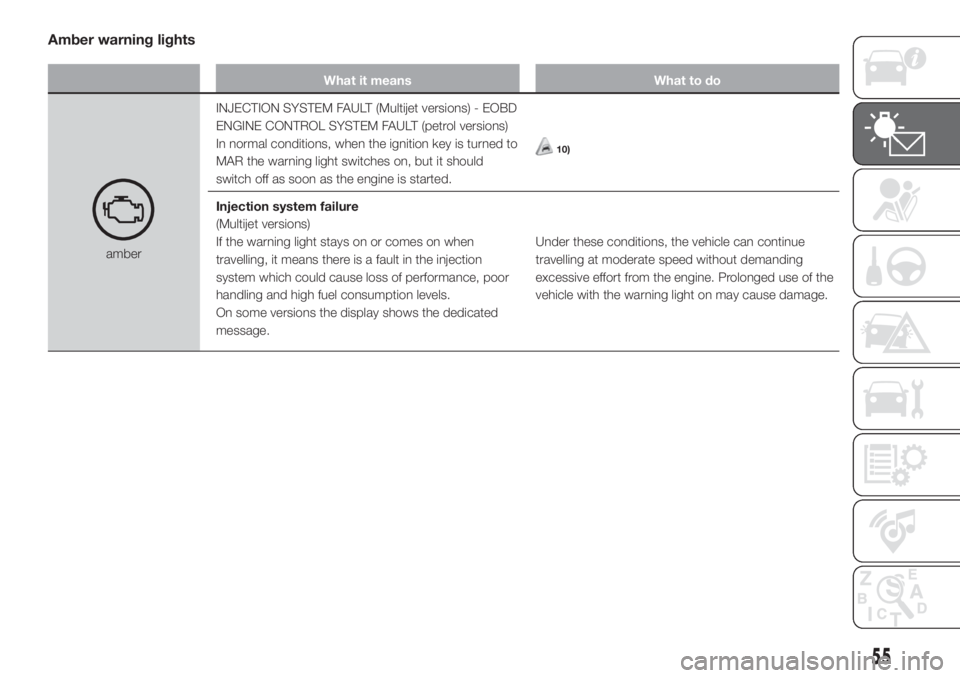
Amber warning lights
What it means What to do
amberINJECTION SYSTEM FAULT (Multijet versions) - EOBD
ENGINE CONTROL SYSTEM FAULT (petrol versions)
In normal conditions, when the ignition key is turned to
MAR the warning light switches on, but it should
switch off as soon as the engine is started.
10)
Injection system failure
(Multijet versions)
If the warning light stays on or comes on when
travelling, it means there is a fault in the injection
system which could cause loss of performance, poor
handling and high fuel consumption levels.
On some versions the display shows the dedicated
message.Under these conditions, the vehicle can continue
travelling at moderate speed without demanding
excessive effort from the engine. Prolonged use of the
vehicle with the warning light on may cause damage.
55
Page 60 of 220

What it means What to do
amberPLUG PREHEATING (Multijet versions) - PLUG
PREHEATING FAULT (Multijet versions)
Glow plugs
(Multijet versions)
This warning light switches on when the key is turned
to MAR. It will switch off as soon as the glow plugs
have reached a preset temperature.
IMPORTANT At high ambient temperatures the
warning light may stay on for an extremely short time.Start the engine as soon as the warning light switches
off.
Glow plug preheating failure
(Multijet versions)
The warning light flashes if there is a fault in the
preheating system.
On some versions the display shows the dedicated
message.Contact a Fiat Dealership as soon as possible.
amberWATER IN DIESEL FILTER (Multijet versions)
The warning light switches on when the ignition key is
turned to MAR, but it should switch off after a few
seconds.
The
warning light switches to indicate presence of
water in the diesel filter.
On some versions the display shows the dedicated
message.11)
amberLow diesel emissions additive (UREA) level warning
(for versions/markets, where provided)
The Diesel Emissions Additive (UREA) low level
warning light
lights if the vehicle has a low UREA
level.
58
KNOWING THE INSTRUMENT PANEL
Page 61 of 220
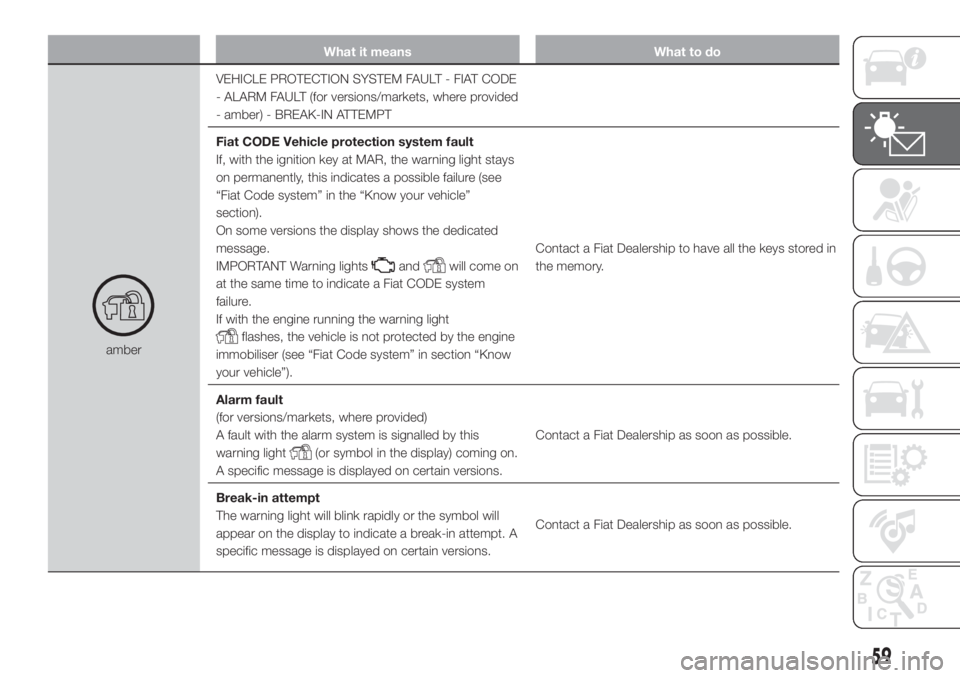
What it means What to do
amberVEHICLE PROTECTION SYSTEM FAULT - FIAT CODE
- ALARM FAULT (for versions/markets, where provided
- amber) - BREAK-IN ATTEMPT
Fiat CODE Vehicle protection system fault
If, with the ignition key at MAR, the warning light stays
on permanently, this indicates a possible failure (see
“Fiat Code system” in the “Know your vehicle”
section).
On some versions the display shows the dedicated
message.
IMPORTANT Warning lights
andwill come on
at the same time to indicate a Fiat CODE system
failure.
If with the engine running the warning light
flashes, the vehicle is not protected by the engine
immobiliser (see “Fiat Code system” in section “Know
your vehicle”).Contact a Fiat Dealership to have all the keys stored in
the memory.
Alarm fault
(for versions/markets, where provided)
A fault with the alarm system is signalled by this
warning light
(or symbol in the display) coming on.
A specific message is displayed on certain versions.Contact a Fiat Dealership as soon as possible.
Break-in attempt
The warning light will blink rapidly or the symbol will
appear on the display to indicate a break-in attempt. A
specific message is displayed on certain versions.Contact a Fiat Dealership as soon as possible.
59
Page 62 of 220
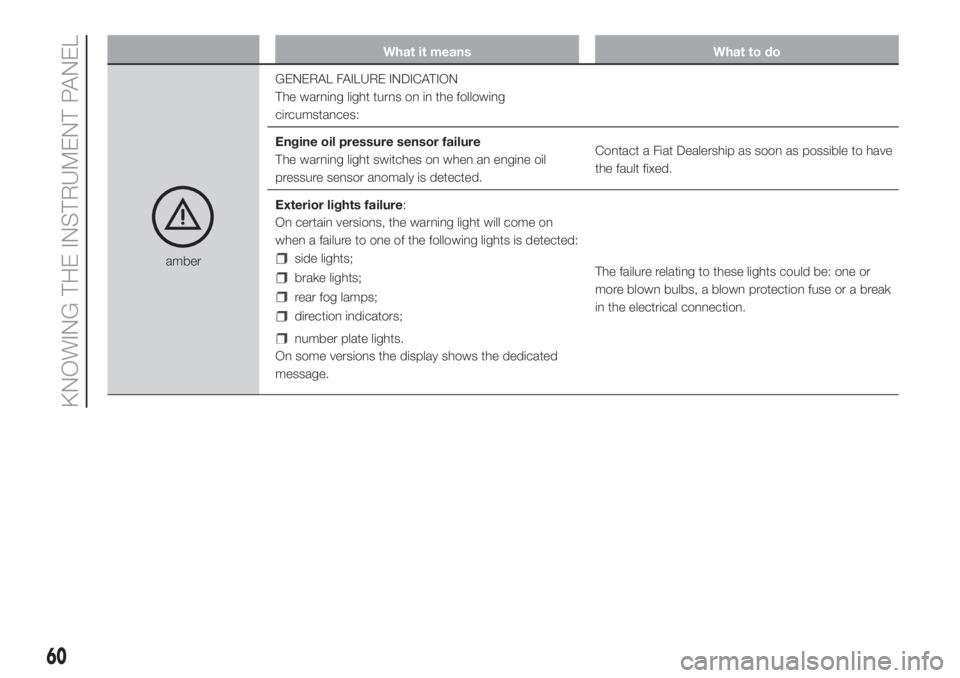
What it means What to do
amberGENERAL FAILURE INDICATION
The warning light turns on in the following
circumstances:
Engine oil pressure sensor failure
The warning light switches on when an engine oil
pressure sensor anomaly is detected.Contact a Fiat Dealership as soon as possible to have
the fault fixed.
Exterior lights failure:
On certain versions, the warning light will come on
when a failure to one of the following lights is detected:side lights;
brake lights;
rear fog lamps;
direction indicators;
number plate lights.
On some versions the display shows the dedicated
message.The failure relating to these lights could be: one or
more blown bulbs, a blown protection fuse or a break
in the electrical connection.
60
KNOWING THE INSTRUMENT PANEL
Page 75 of 220

43)The ABS gets the most from the
available grip, but it cannot improve it; you
should therefore take every care when
driving on slippery surfaces and not take
unnecessary risks.
44)If only the
instrument panel
warning light comes on (with a message in
the multifunction display on some
versions), stop the vehicle immediately and
contact the nearest Fiat Dealership. Any
loss of fluid will affect the brake system
functionality, both conventional and
ant-lock wheels.
ESC (Electronic
Stability Control)
SYSTEM
(for versions/markets, where provided)
This is an electronic system that
controls vehicle stability in the event of
tyre grip loss, helping to maintain
directional control. The system
is capable of recognising potentially
dangerous situations in terms of vehicle
stability and intervenes automatically
on the brakes in a differentiated manner
for the four wheels in order to provide
a stabilizing torque.
The ESC system switches on
automatically when the engine is
started and cannot be switched off.
The ESC system also includes the
following systems:
Hill Holder
ASR
MSR
HBA
SYSTEM INTERVENTION
This is signalled by the flashing of the
warning light in the instrument panel,
to inform the driver that the vehicle is
in critical stability and grip conditions.Switching the system on
The ESC system is automatically
activated when the vehicle is started
and cannot be deactivated.
Fault warnings
In the event of a failure, the ESC will be
automatically switched off and the
warning light
will come on constantly
in the instrument panel along with a
message in the multifunction display
(for versions/markets where provided)
(see “Warning lights and messages”
section in the "Knowing the instrument
panel" chapter). Contact a Fiat
Dealership as soon as possible.
45) 46) 47)
HILL HOLDER SYSTEM
(for versions/markets, where provided)
It is an integral part of the ESC system
and facilitates starting on an incline.
It is automatically activated in the
following conditions:
uphill: vehicle stationary on a road
with a gradient higher than 5%, engine
running, brake pedal pressed and
gearbox in neutral or gear other than
reverse;
downhill: vehicle stationary on a road
with a gradient higher than 5%, engine
running, brake pedal pressed and
reverse gear engaged.
73
Page 76 of 220

When setting off, the ESC system
control unit maintains the braking
pressure on the wheels until the torque
necessary for starting is reached, or
in any case for a maximum of 2
seconds, allowing your right foot to be
moved easily from the brake pedal to
the accelerator. When the 2 seconds
have elapsed, without starting, the
system is automatically deactivated,
gradually releasing the braking
pressure. During this release stage, the
typical brake disengagement noise
indicating that the vehicle is going to
move imminently will be heard.
Fault warnings
System failure is indicated by
instrument panel warning light
with
digital display and warning light
on
the instrument panel with multifunction
display (for versions/markets, where
provided) (see section “Warning lights
and messages” in the "Knowing the
instrument panel" chapter).
IMPORTANT The Hill Holder system is
not a parking brake, therefore do not
leave the vehicle without activating the
handbrake, switching off the engine
and engaging first gear.
48)
ASR SYSTEM (Antislip
Regulation)
(for versions/markets, where provided)
This is a traction control system that
cuts in automatically every time one or
both drive wheels slip.
Depending on the slipping conditions,
two different control systems are
activated:
if the slipping involves both drive
wheels, the ASR intervenes reducing
the power transmitted by the engine;
if the slipping only involves one
of the drive wheels, the ASR intervenes
automatically braking the wheel that
is slipping.
The action of the ASR system is
especially useful in the following
conditions:
slipping of the inner wheel round
bends due to dynamic variations in the
load of excessive acceleration;
excessive power transmitted to the
wheels, also in relation to road surface
conditions;
acceleration on slippery, snowy or
icy road surfaces;
in the case of loss of grip on a wet
surface (aquaplaning).
48) 49) 50) 51)
MSR SYSTEM (engine
drive regulation)
This is an integral part of the ESC
system that, in the event of a sudden
gear down shift or an ABS braking,
cuts in and provides torque to the
engine thus preventing excessive
driving wheel drive which, especially in
poor grip conditions, can lead to a
loss of stability.
Turning the ASR system on/off
The ASR comes on automatically
whenever the engine is started.
When travelling, the ASR system can
be switched off and on again pressing
button fig. 81 located among the
controls in the instrument panel.
Switching off is shown by the warning
light
on the instrument panel
switching on together with a message
shown in the multifunction display,
for versions/markets where provided.
If the ASR is switched off while driving,
it is automatically switched on again
when the car is started up.
When travelling on snowy roads with
snow chains, it may be helpful to turn
the ASR off: in fact, in these conditions,
the drive wheels skidding when setting
off gives you better traction.
52)
74
SAFETY
Page 100 of 220

STARTING THE
ENGINE
The vehicle is fitted with an electronic
engine lock device: if the engine fails to
start, see the paragraph “The Fiat
CODE system” in section “Know your
vehicle”.
On some versions, the Start&Stop
system will be activated every time the
vehicle is started, even though it was
deactivated before switching the vehicle
off.
96) 97)
13) 14) 18) 19)
PROCEDURE FOR
PETROL VERSIONS
Proceed as follows:
engage the handbrake;
put the gear lever into neutral;
fully depress the clutch pedal
without touching the accelerator;
turn the ignition key to AVV and
release it as soon as the engine starts.PROCEDURE FOR DIESEL
VERSIONS
Proceed as follows:
engage the handbrake;
put the gear lever into neutral;
turn the ignition key to MAR
position: the
warning light will light
up on instrument panel;
wait for the warning lightsand
to turn off, which will happen faster
the warmer the engine is;
fully depress the clutch pedal
without touching the accelerator;
turn the ignition key to the AVV
position as soon as the warning light
turns off. Waiting too long will waste
the heating work carried out by the
plugs.
Release the key as soon as the engine
starts.
With cold engine, the accelerator must
be entirely released when turning the
ignition key to position AVV.
15)
PROCEDURE FOR
NATURAL POWER
VERSIONS
The engine always starts up on petrol
independently of the previously
selected mode.
16)
PROCEDURE FOR
VERSIONS WITH
COMFORT-MATIC
TRANSMISSION
The system allows the engine to be
started both with a gear engaged and
with the transmission in neutral (N).
Always press the brake pedal with the
gear engaged.
It is advisable to place the gear lever in
neutral (N) before starting the engine.
17)
IMPORTANT If the engine does not
start at the first attempt, return the
ignition key to STOP before repeating
the starting procedure. If the warning
light remains on together with warning
light
when the ignition key is at
MAR, turn the key to STOP and then
back to MAR; if the warning light stays
on, try with the other keys provided
with the vehicle. If you still cannot start
the engine, perform an emergency
start (see “Emergency starting” in the
“In an emergency” section) and go to a
Fiat Dealership.
98
STARTING AND DRIVING
Page 113 of 220
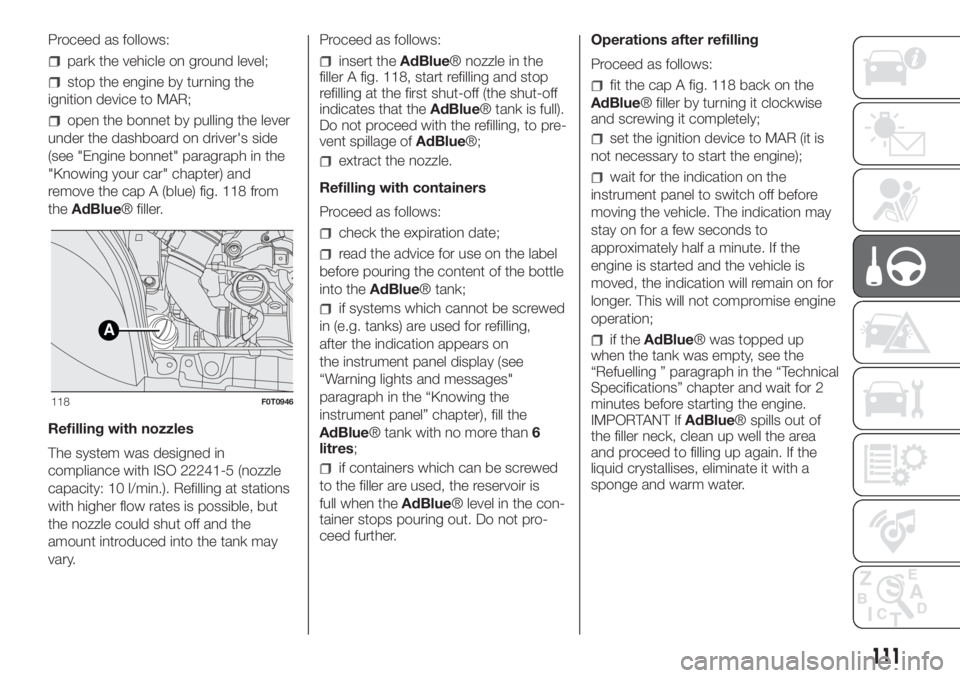
Proceed as follows:
park the vehicle on ground level;
stop the engine by turning the
ignition device to MAR;
open the bonnet by pulling the lever
under the dashboard on driver's side
(see "Engine bonnet" paragraph in the
"Knowing your car" chapter) and
remove the cap A (blue) fig. 118 from
theAdBlue® filler.
Refilling with nozzles
The system was designed in
compliance with ISO 22241-5 (nozzle
capacity: 10 l/min.). Refilling at stations
with higher flow rates is possible, but
the nozzle could shut off and the
amount introduced into the tank may
vary.Proceed as follows:
insert theAdBlue® nozzle in the
filler A fig. 118, start refilling and stop
refilling at the first shut-off (the shut-off
indicates that theAdBlue® tank is full).
Do not proceed with the refilling, to pre-
vent spillage ofAdBlue®;
extract the nozzle.
Refilling with containers
Proceed as follows:
check the expiration date;
read the advice for use on the label
before pouring the content of the bottle
into theAdBlue® tank;
if systems which cannot be screwed
in (e.g. tanks) are used for refilling,
after the indication appears on
the instrument panel display (see
“Warning lights and messages"
paragraph in the “Knowing the
instrument panel” chapter), fill the
AdBlue® tank with no more than
litres;
if containers which can be screwed
to the filler are used, the reservoir is
full when theAdBlue® level in the con-
tainer stops pouring out. Do not pro-
ceed further.Operations after refilling
Proceed as follows:
fit the cap A fig. 118 back on the
AdBlue® filler by turning it clockwise
and screwing it completely;
set the ignition device to MAR (it is
not necessary to start the engine);
wait for the indication on the
instrument panel to switch off before
moving the vehicle. The indication may
stay on for a few seconds to
approximately half a minute. If the
engine is started and the vehicle is
moved, the indication will remain on for
longer. This will not compromise engine
operation;
if theAdBlue® was topped up
when the tank was empty, see the
“Refuelling ” paragraph in the “Technical
Specifications” chapter and wait for 2
minutes before starting the engine.
IMPORTANT IfAdBlue® spills out of
the filler neck, clean up well the area
and proceed to filling up again. If the
liquid crystallises, eliminate it with a
sponge and warm water.A
118F0T0946
111
6
Page 114 of 220

IMPORTANT
DO NOT EXCEED THE
MAXIMUM LEVEL: this could cause
damage to the reservoir. UREA
freezes at under -11 °C. Although
the system is designed to operate
below the freezing point of the
UREA, it is advisable not to fill the
tank beyond the maximum level
because if the UREA freezes the
system can be damaged. Follow the
instructions in the “Topping up
AdBlue® diesel emissions additive
(UREA)” paragraph in this chapter.
If the UREA is spilled on painted
surfaces or aluminium, immediately
clean the area with water and use
absorbent material to collect the
fluid that has been spilled on the
ground.
Do not try to start the engine if
UREA was accidentally added to
the Diesel fuel tank, this can result
in serious engine damage, contact
a Fiat Dealership.
Do not add additives or other
fluids to AdBlue®, doing so could
damage the system.
The use of non-conforming or
degraded AdBlue® may lead to
indications appearing on the instru-
ment panel display (see “Warning
lights and messages" paragraph in
the “Knowing the instrument panel”
chapter).
Never pour AdBlue® into
another container: it could be con-
taminated.
In case of damage to the
sewage system of exhaust gas
resulting from the use of additives /
tap water, the introduction of diesel
fuel, or at least by not fulfilling the
requirements, the warranty expires.
If the AdBlue® runs out, see
“Warning lights and messages"
paragraph in the “Knowing the
instrument panel” chapter to con-
tinue using the vehicle normally.
AdBlue® (UREA) storage
AdBlue® (UREA) is a very stable prod-
uct with a long shelf life. Stored at tem-
peratures LOWER than 32 °C, it has a
shelf life of at least one year.
Follow the instructions on the label of
the container.
112)
METHANE ENGINES
(NATURAL POWER)
METHANE GAS FILLER
The methane filler is located near the
petrol filler fig. 119.
It has a check valve, located in the filler
body.
To access the filler, undo the capAfig.
119 turning it anticlockwise.
The profile of fillerBfig. 120 for refilling
is the universal type, compatible with
Italian and "NGV1" standards.
119F0T0360
120F0T0336
112
STARTING AND DRIVING
Page 116 of 220
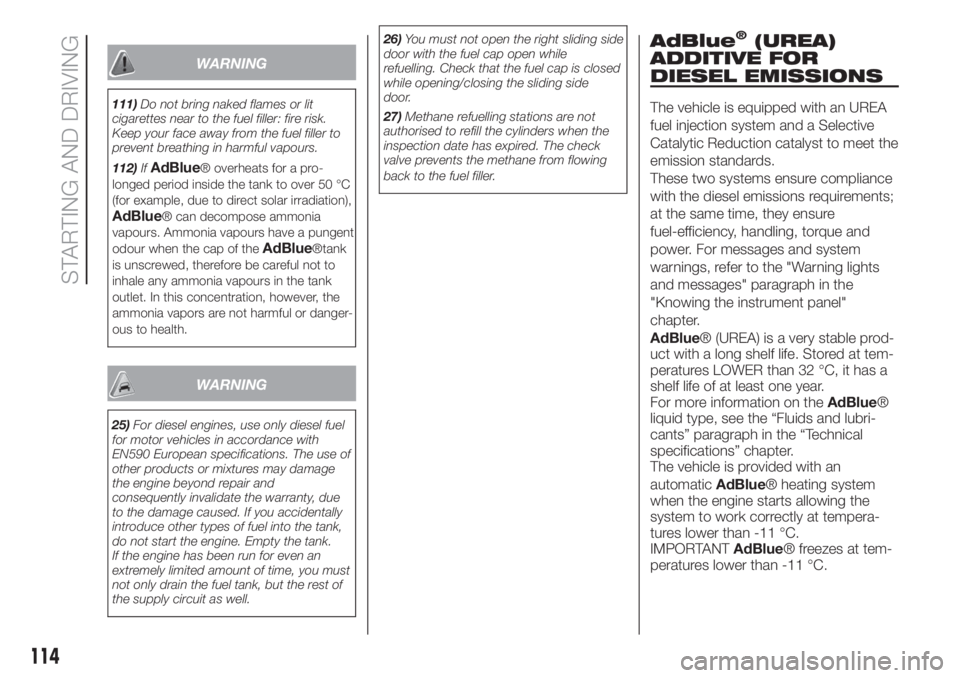
WARNING
111)Do not bring naked flames or lit
cigarettes near to the fuel filler: fire risk.
Keep your face away from the fuel filler to
prevent breathing in harmful vapours.
112)If
AdBlue® overheats for a pro-
longed period inside the tank to over 50 °C
(for example, due to direct solar irradiation),
AdBlue® can decompose ammonia
vapours. Ammonia vapours have a pungent
odour when the cap of the
AdBlue®tank
is unscrewed, therefore be careful not to
inhale any ammonia vapours in the tank
outlet. In this concentration, however, the
ammonia vapors are not harmful or danger-
ous to health.
WARNING
25)For diesel engines, use only diesel fuel
for motor vehicles in accordance with
EN590 European specifications. The use of
other products or mixtures may damage
the engine beyond repair and
consequently invalidate the warranty, due
to the damage caused. If you accidentally
introduce other types of fuel into the tank,
do not start the engine. Empty the tank.
If the engine has been run for even an
extremely limited amount of time, you must
not only drain the fuel tank, but the rest of
the supply circuit as well.26)You must not open the right sliding side
door with the fuel cap open while
refuelling. Check that the fuel cap is closed
while opening/closing the sliding side
door.
27)Methane refuelling stations are not
authorised to refill the cylinders when the
inspection date has expired. The check
valve prevents the methane from flowing
back to the fuel filler.
AdBlue®(UREA)
ADDITIVE FOR
DIESEL EMISSIONS
The vehicle is equipped with an UREA
fuel injection system and a Selective
Catalytic Reduction catalyst to meet the
emission standards.
These two systems ensure compliance
with the diesel emissions requirements;
at the same time, they ensure
fuel-efficiency, handling, torque and
power. For messages and system
warnings, refer to the "Warning lights
and messages" paragraph in the
"Knowing the instrument panel"
chapter.
AdBlue® (UREA) is a very stable prod-
uct with a long shelf life. Stored at tem-
peratures LOWER than 32 °C, it has a
shelf life of at least one year.
For more information on theAdBlue®
liquid type, see the “Fluids and lubri-
cants” paragraph in the “Technical
specifications” chapter.
The vehicle is provided with an
automaticAdBlue® heating system
when the engine starts allowing the
system to work correctly at tempera-
tures lower than -11 °C.
IMPORTANTAdBlue® freezes at tem-
peratures lower than -11 °C.
114
STARTING AND DRIVING